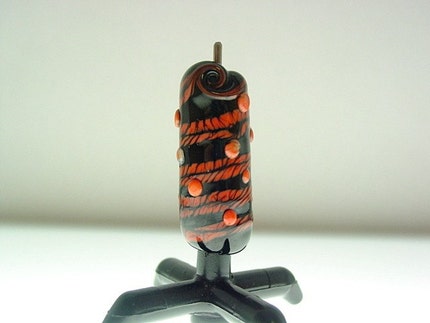But let's start with the simple. Basic stringer is one color. It's is a simple a single rod, heated in the flame and pulled to a smaller size:
 To make the icing decorations on this toffee bar candy bead, I pulled brown stringer from the same rod as the base bead.
To make the icing decorations on this toffee bar candy bead, I pulled brown stringer from the same rod as the base bead.
Then we move into the slightly more complicated "cased cane." Once layers of glass are involved, we start calling it cane. Casing means another layer of glass is coating an inner layer. The inside is encased in more glass. This is a great way to work with a fussy color that reacts (see yesterday's post) to other colors, such as transparent pink (a/k/a/ rubino di oro or gold rose). Casing pink in clear prevents it from reacting and getting all gray and ugly while still allowing it to be pink.
Cased cane is also a fabulous way to pull a custom color! If you understand anything about color i.e. Yellow + Blue = Green, you never run out of color! By taking a yellow rod and coating it with blue transparent, you'll end up with a really pretty green. OR like below, I like my pinks a little orange. This cane is coral+rubino+clear.

Next comes the more elaborate vine cane. This is cane that starts with a base color, gets striped with thin stringers of a darker or lighter color and then is encased. Here are some examples of vine and leaf cane from my table:
 Note the stripes above. Many lampworkers cut into the base rod to apply those stripes but I like mine really even and use a graphite shaping block from Weaver Industries:
Note the stripes above. Many lampworkers cut into the base rod to apply those stripes but I like mine really even and use a graphite shaping block from Weaver Industries:
The hot base rod is placed in the mold which generates a perfectly scored rod. Stringer is added to the scores and the whole thing is encased and pulled thin. There are examples of rose cane, leaf cane and vine cane throughout this bead:

Next comes the much more complicated twistie. Twisties are fussy and it's taken me ages to realize why! Some glasses are "soupy" - they melt faster. Soupy glasses tend to take over the twist! White is the soupiest glass of all. To compensate, I use three - five times as much of the non-white color to keep the white in balance! The other issue is getting a really even pull. Here are a few twisities:

And since I rarely use them, I'm going to use an example from one of the Fire Divas who uses twisties frequently, Theresa of TeaseBeads. Check out this focal:

Even more complicated is the wig wag cane or V-rod. These are twisties that are pulled back and forth to create unusal twists and turns in the rod. Sarah Hornik pulls them by hand. These were pulled with the aid of a kiln, making it much easier to get them even.
 The final type of cane I'll show you is ribbon cane. This is formed from a paddle of glass, striped with stringer and care is taken to keep it FLAT in pulling. These make fabulous textured scarves for snowmen or belts. I've even made ribbons flowing off Christmas ornaments.
The final type of cane I'll show you is ribbon cane. This is formed from a paddle of glass, striped with stringer and care is taken to keep it FLAT in pulling. These make fabulous textured scarves for snowmen or belts. I've even made ribbons flowing off Christmas ornaments.
So there you have it... a tour into the world of stringers and canes. I hope you'll take what you've learned and look at some beads a little more closely. Take a moment to realize how much artistry goes into each bead. Does the bead maker use "flat color" - one color stringer - or is she trying to create a work of art by layering color? Does she give thought to the basic art principles of highlights, lowlights and midtones? If she uses single colors, does she do amazing things with it?
There's much to consider when buying lampwork. Each bead is a reflection of the hand of the artist.









1 comment:
Love this Holly! It helps people get a deeper look into some of the work involved with lampworking!
Post a Comment